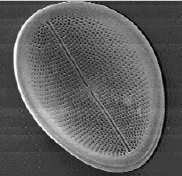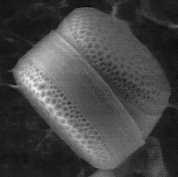







Diatoms are single-celled organisms which secrete intricate skeletons. These may be elongate, with a bilateral plane of symmetry, or they may be round and radially symmetrical. Many diatoms are slightly asymmetrical, though they generally fall into one of these two categories.
The skeleton of a diatom, or frustule, is made of very pure silica coated with a layer of organic material. This skeleton is divided into two parts, one of which (the epitheca) overlaps the other (the hypotheca) like the lid of a box or petri dish. Observe the diatom frustule below at right, in which the two halves have been pushed slightly askew. Both epitheca and hypotheca are made up of two or more parts: the valve, a more or less flattened plate, and at least one cingulum, a hoop-like rim. This electron micrograph (below at left) shows the inside of a single valve of Cocconeis.


As is visible in the photographs, both parts of a frustule may be highly perforated. Pennate diatoms show a long slit, the raphe, along the long axis. Through the raphe, the living diatom secretes mucilage, with which it may attach to a substrate or move by gliding over the substrate.
Within their silica walls, diatoms show a typical level of eukaryote organization. Living diatoms contain several chloroplasts, where photosynthesis takes place.


